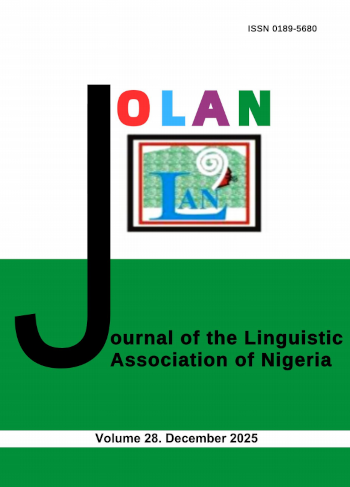Ọ̀rọ̀-Aṣẹ̀pọ́n nínú Ẹ́hun Èdè Yorùbá (The Modifier in Yorùbá Construction)
Keywords:
Ìsọ̀rí-ọ̀rọ̀ onítumọ̀ àdámọ, Ọ̀rọ̀-Aṣẹ̀pọ̀n aṣàfikún, Ọ̀rọ̀-Aṣẹ̀pọ́n aṣàmúpé, ọ̀rọ̀-ìṣe aṣorí, content or lexical words, adjunct modifier, complement modifier, the head verbAbstract
Yorùbá
Ọ̀rọ̀-Aṣẹ̀pọ́n (EP) ni ọ̀rọ̀ tí ó ń pọ́n ọ̀rọ̀ tàbí ìsọ mìíràn nínú ẹ̀hun èdè Yorùbá. Ìsọ̀rí-ọ̀rọ̀ yìí lè jẹ́ èyí tí óń ṣe àfikún ìtumọ́ ọ̀rọ̀tí ó ń pọ́n tàbí kí ó mú kí itumọ̀ ọ̀rọ̀náà pé. Ọ̀rọ̀-aṣẹ̀pọ́n máa ń pọ́n ọ̀rọ̀-ìṣe asorí, odindi gbólóhùn, ọ̀rọ̀-orúkọ àti àwọn ẹ̀yán kan nínú àpólà orúkọ. Àwọn ọ̀rọ̀-aṣẹ̀pọ́n kan máa ń jẹ kànńpá nínú ẹ̀hun nítorí pé wọ̀n jẹ́àmúpé fún ọ̀rọ̀ tí wọ́n ń pọ́n, àwọn kan sì máa ń jẹ́ ìwọ ̀fún nítorí pé wọ́n kàn ṣe àfikún ìtumọ̀ ọ̀rọ̀ tí wọ́n ń pọ́n lásán ni. Òrò-asèpoń agbaboti òro ̀-asèpón aláìgbàboni alè yà so ́tònínú e ̀hun èdè Yorùbá. Àpólà tí ò rò -aṣẹ̀pọ́n ti jéorí ni àpólà aṣẹ̀pọ́n (APEP), oríṣi àpólàaṣẹ̀pọ́n méjì ni a lè yà sọ́tọ̀ , àwọn ni àpólà aṣẹ̀pọ́n alábọ̀,.nítorí àwọn ọ̀rọ̀-aṣẹ̀pọ́n kan kò lè dá wà nínúàpólà aṣẹ̀pọ́n, wọ́n gbọ́dọ̀ gba àpólà orúkọ gẹ́gẹ́ bí àbọ̀, àti àpólà aṣẹ̀pọ́n aláìlábọ̀, àwọn ọ̀rọ̀-aṣẹ̀pọ́n tíwọ́n lè dá wà nínú àpólà aṣẹ̀pọ́n. Nínú bébà yìí a óò fún ọ̀rọ̀-aṣẹ̀pọ́n ní oríkì, a óò ṣàlàyé ẹ̀yà àti àbùdáọ̀rọ̀-aṣẹ̀pọ́n, a óò sì ṣàgbéyẹ̀wò ìhun àpólà aṣẹ̀pọ́n (APEP) ni ibi tí ọ̀rọ̀-aṣẹ̀pọ́n ti jẹ́ orí.
English
The modifier is a word used to modify another word or construction in Yorùbá. It can be an adjunct which adds to the meaning of the word it modifies or a complement which completes the meaning of that word. A modifier can be transtive or intransitive, it can be employed to modify a head verb in a verb phrase (VP), it can modify a whole sentence, a noun phrase (NP) or a qualifier in an NP. Some modifiers are obligatory in the construction because the complement the word they modify; some must take objects while some are without objects. The phrase where the modifier is the head is the modifier phrase (ModP), we identify two types of modifier phrases in Yorùbá constructions, modifier phrases that include objects, where the modifier head must obligatorily select an object, and modifier phrases without objects where the modifier head is the sole constituent in the phrase. In this paper, we shall define the modifier, explain its features and type and examine the phrase where the modifier is the head.
References
Awóbùlúyì, O . 1978. Essentials of Yorùbá Grammar, Ìbàdàn: UPL.
Awobuluyi, O . 2013. Ẹ̀kọ́ Gírámà Èdè Yorùbá. Oṣogbo: ATAM Limited
Bámgbóṣé, A. 1966. A Grammar of Yorùbá, Cambridge:CUP
Bámgbóṣé, A. 1967. A Short Yorùbá Grammar.Ibadan: HEB (Nigeria) Ltd
Bámgbós é, A. 1990. Fonó̩ ló̩ jì àti Gírámà Yorùbá. Ìbàdàn: UPL.
Taiwo, O. 2011. Mofọ́lọ́jì: Àtúnṣe kejì: Ibadan, Akada Universal Books
Taiwo, O and Olakolu, T, 2020. Ẹ̀pọ́n nínú Ìhun Àpólà Ìṣe Èdè Yorùbá JOLAN: Journal of the Linguistic Association of Nigeria, Volume 23 No 1, o.i. 16 - 35














